A. Stotz All Weather Strategy – May 2021
The All Weather Strategy came in slightly below the traditional 60/40 portfolio in the past three months. Stimulus and vaccine news to drive the US and Developed Europe equity, together with China, the recovery should drive commodities. We switch into Developed markets equity but stay with our target weights for the various asset classes.
The A. Stotz All Weather Strategy is Global, Long-term, and Diversified:
- Global – Invests globally, not only Thailand
- Long-term – Gains from long-term equity return, while trying to reduce a portion of losses during equity market downturns
- Diversified – Diversified globally across four asset classes
The All Weather Strategy is available in Thailand through FINNOMENA. Please note that this post is not investment advice and should not be seen as recommendations. Also, remember that backtested or past performance is not a reliable indicator of future performance.
Review
Lower equity allocation was a wrong call
- In our past revision of AWS, we decreased our equity allocation to 65%
- This appears to have been the wrong call as equity markets were strong
Developed markets outperformed
- In the past three months, Developed markets equity performed strongly, while Emerging markets underperformed substantially
- Unfortunately, we did not position well for this move
Allocated to the wrong regions within equity
- We had a 25% target allocation to Asia Pacific ex Japan and Emerging markets
- These led to the strategy’s underperformance relative to the traditional 60/40 portfolio
- The two were the worst-performing equity markets in the past three months
Correctly staying with low bond exposure
- In the previous revision, we kept our bond target allocation at 5%
- Due to the risk of rising interest rates, bonds appeared less attractive to us relative to equity
- Our strategy remains to allocate this bond portion to Thai treasuries, rather than a mix of global government and corporate bonds
Our 25% commodities allocation boosted the strategy’s return
- We raised our commodities target allocation to 25% in our March revision
- This was a good call as it was the best performing asset class over the past three months
- The inflation narrative and global recovery continued to spread, driving this commodity performance
Gold did well in the past three months
- In our last revision, we kept our gold allocation at 5%
- Remember that we also have some gold exposure in the commodities allocation
- As the market started pricing in an increased risk of inflation, gold performed strongly in the past three months
- A rebound in Chinese demand for jewelry, bars, and coins helped the gold price further
Past 3 months: Commodities performed well but Emerging markets underperformed Developed
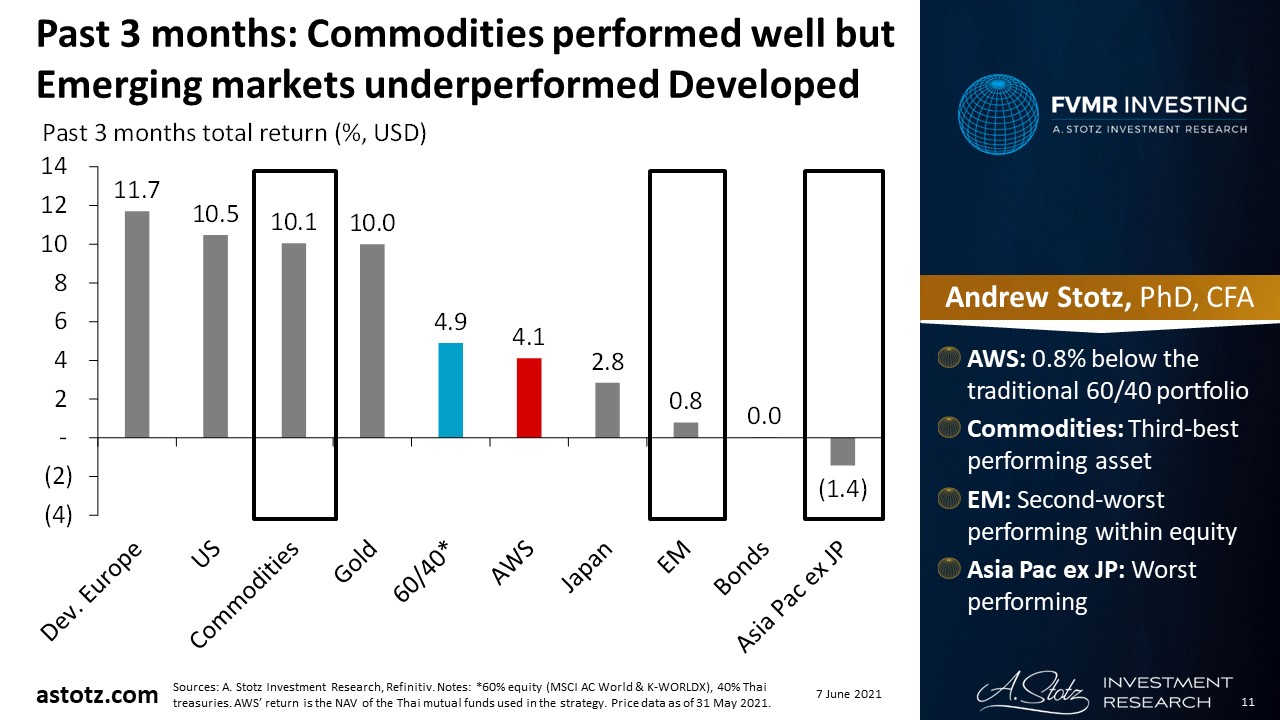
Past performance should not be taken as an indication or guarantee of future performance, and no representation or warranty, expressed or implied is made regarding future performance.
- All Weather Strategy: 0.8% below the traditional 60/40 portfolio
- Commodities: Third-best performing asset
- Emerging Markets: Second-worst performing within equity
- Asia Pacific ex Japan: Worst performing
Since inception: Slightly below a traditional 60/40 portfolio but with lower drawdowns
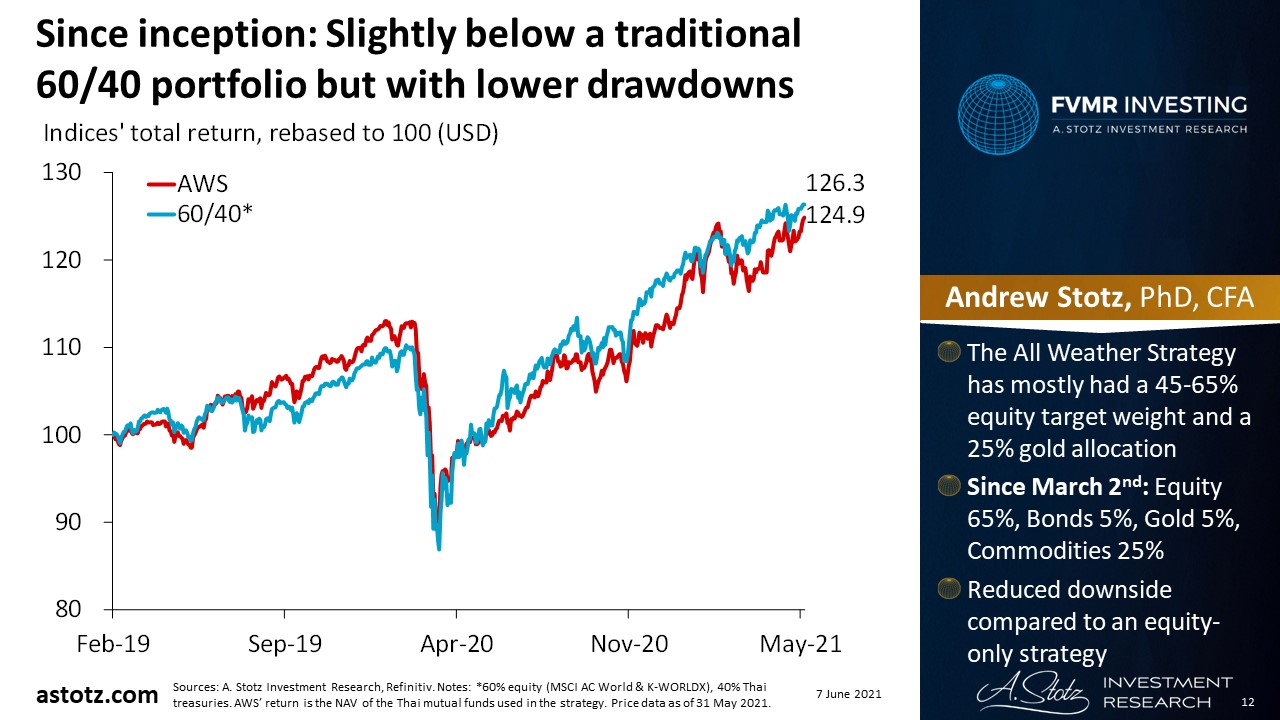
Past performance should not be taken as an indication or guarantee of future performance, and no representation or warranty, expressed or implied is made regarding future performance.
- The All Weather Strategy has mostly had a 45-65% equity target weight and a 25% gold allocation
- Since March 2nd: Equity 65%, Bonds 5%, Gold 5%, Commodities 25%
- Reduced downside compared to an equity-only strategy
Since inception: The All Weather Strategy has experienced less volatility than the traditional 60/40 portfolio
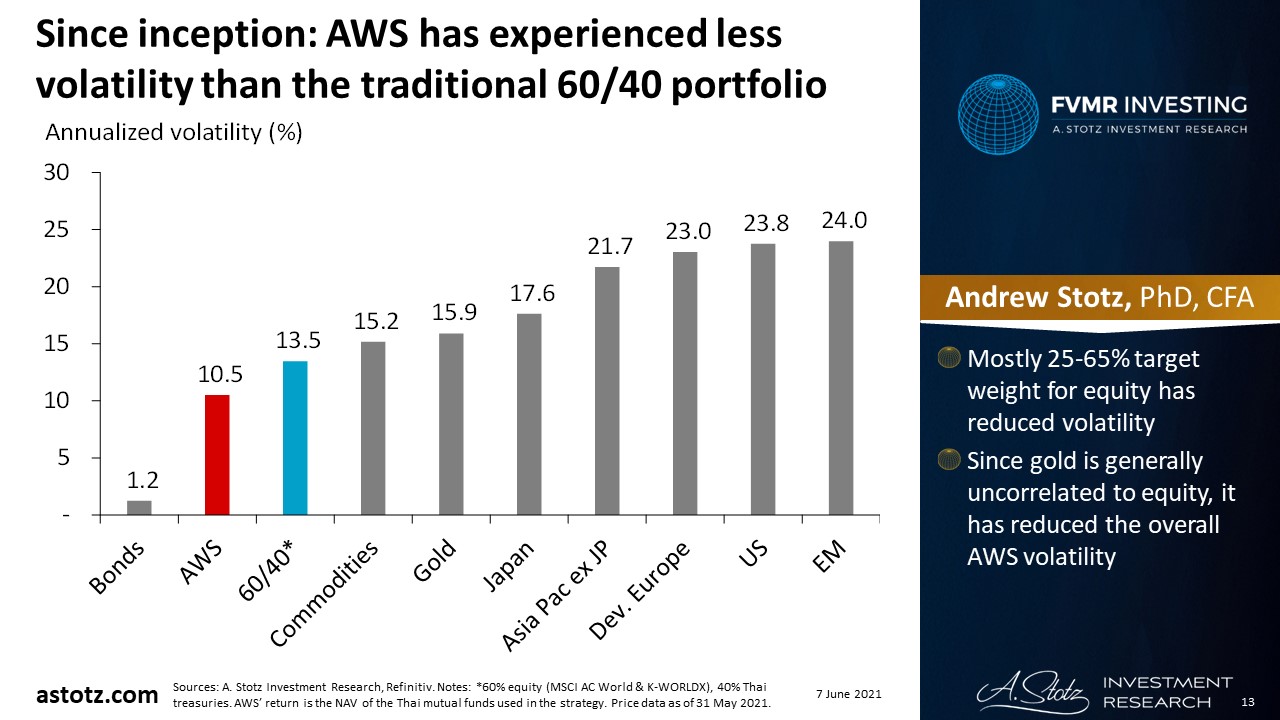
Past performance should not be taken as an indication or guarantee of future performance, and no representation or warranty, expressed or implied is made regarding future performance.
- Mostly 25-65% target weight for equity has reduced volatility
- Since gold is generally uncorrelated to equity, it has reduced the overall strategy’s volatility
Since inception: The All Weather Strategy has lost less than the 60/40 portfolio on 8 out of the 10 worst days
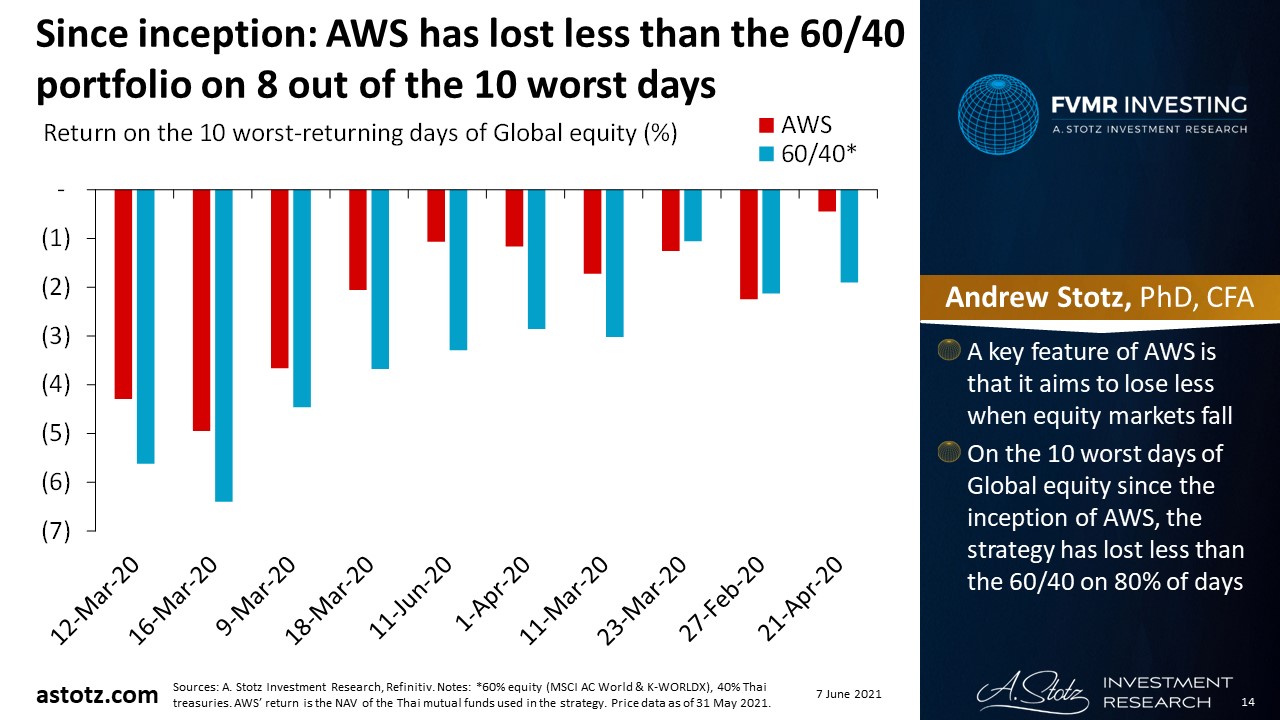
Past performance should not be taken as an indication or guarantee of future performance, and no representation or warranty, expressed or implied is made regarding future performance.
- A key feature of the All Weather Strategy is that it aims to lose less when equity markets fall
- On the 10 worst days of Global equity since the inception of AWS, the strategy has lost less than the 60/40 on 80% of days
Since inception: The All Weather Strategy has outperformed the traditional 60/40 portfolio in 67% of months
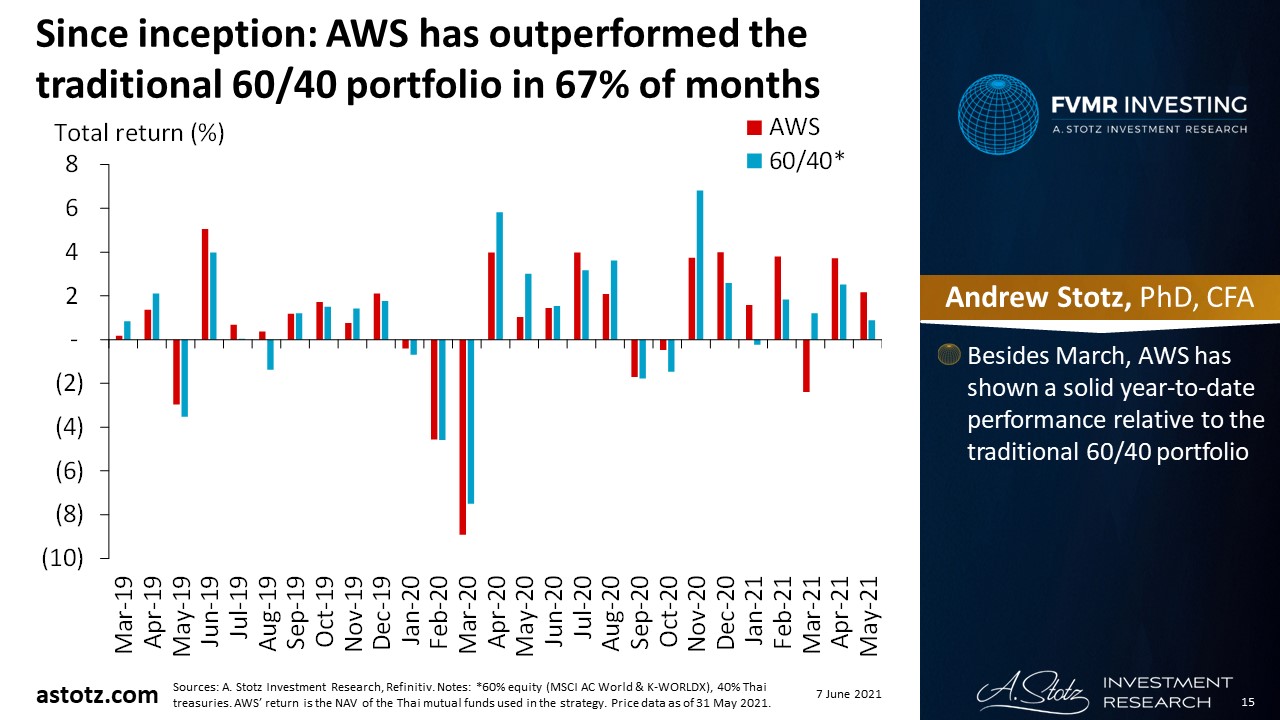
Past performance should not be taken as an indication or guarantee of future performance, and no representation or warranty, expressed or implied is made regarding future performance.
- Besides March, the All Weather Strategy has shown a solid year-to-date performance relative to the traditional 60/40 portfolio
Weights
Unchanged in terms of asset classes
- In terms of asset classes, we keep our allocation
- Keep equity at 65% and commodities at 25%
- Keep bonds and gold at 5% each
- Increase the US and Developed Europe to 25%
- Reduce Emerging markets and Asia Pacific ex Japan to 5%
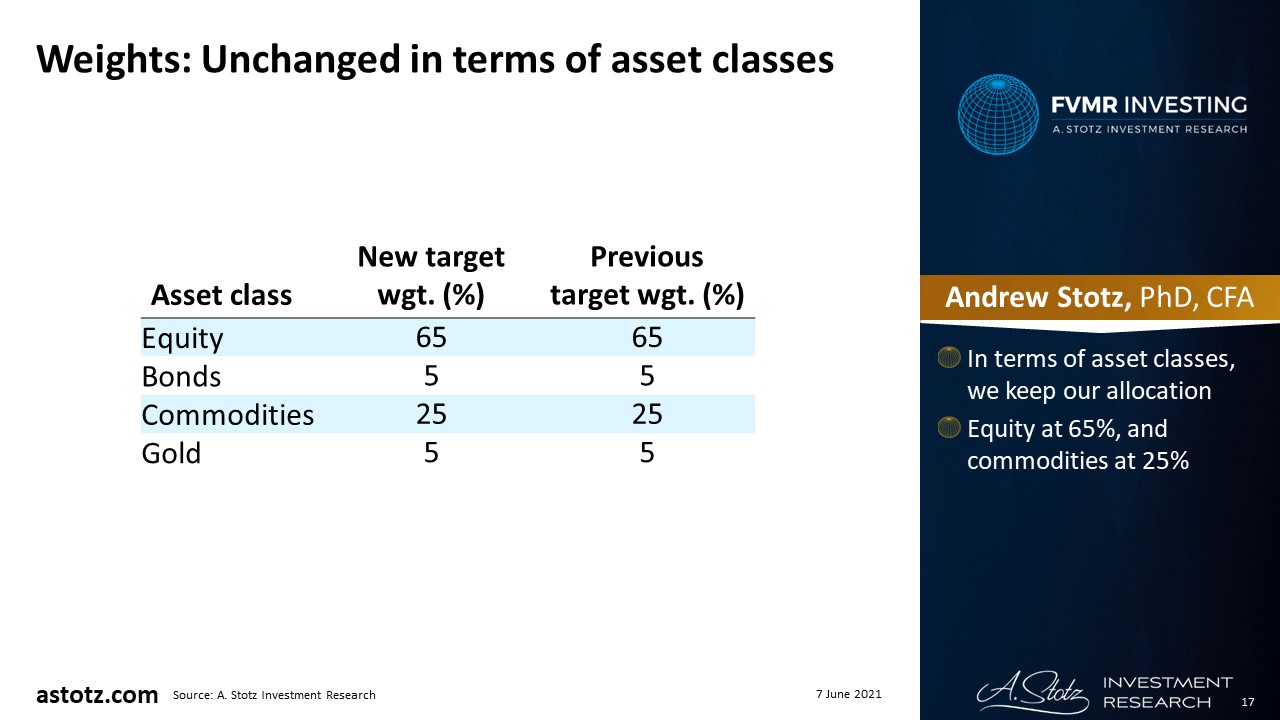
- In terms of asset classes, we keep our allocation
- Equity at 65%, and commodities at 25%
Switching to Developed markets within equity
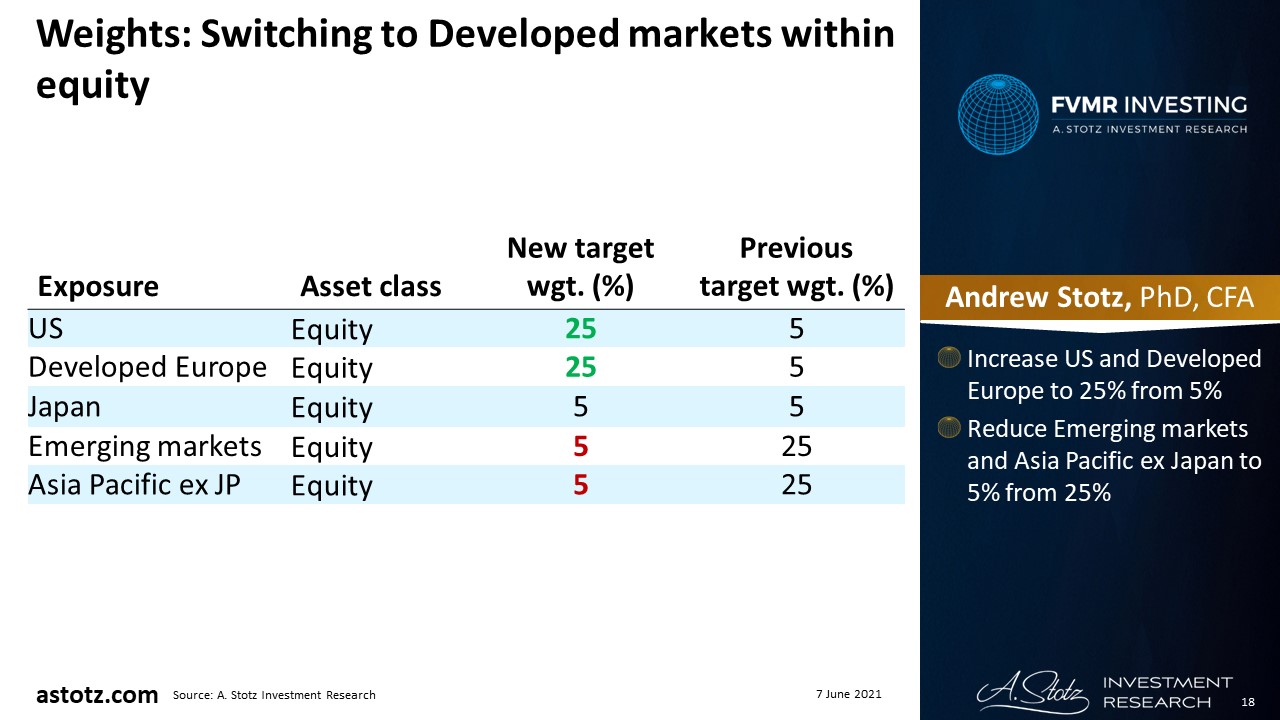
- Increase US and Developed Europe to 25% from 5%
- Reduce Emerging markets and Asia Pacific ex Japan to 5% from 25%
Outlook
Vaccine and stimulus news drive markets
- Besides China, Western Developed markets are where recovery is happening the most
- Vaccine rollouts are quick, and stimulus helps consumer spending reaching new heights
- Fed and the ECB are open to overshoot their inflation targets
- This could drive inflation expectations further
Massive government spending proposed by President Biden
- President Biden’s US$2.7trn American Jobs Plan is focused on infrastructure, such as transportation, water treatment, clean energy, and high-speed broadband
- Together with the American Families Plan, the proposed total spending reaches US$4trn
US government spending spur inflation
- US government spending should stimulate both growth and inflation
- Positive sentiment to drive US Equity in the near term
ECB is expected to let inflation run
- In May, inflation in the Eurozone came in above expectations
- ECB President Christine Lagarde has indicated that she thinks inflation is transitory
- As a result, the central bank is not going to tighten its policy based on the currently experienced inflation
Faster vaccine rollouts drive positive sentiment in Developed Europe
- Faster vaccine rollouts help the economic recovery
- Together with an accommodative monetary policy, we have a positive near-term outlook
- We think a positive sentiment is going to drive up Developed Europe equity
Asia is still battling the pandemic
- In Asia, countries are again seeing rising COVID-19 cases and are slow with vaccine rollouts compared to Western countries
- This could delay the economic recovery in Asia and Emerging markets where Asia has been an important growth driver
- Asia and Emerging markets indices have yet to return to previous peaks
Commodities should do well on the back of an economic recovery in the US, EU, and China
- US, EU, and China’s economic recovery should spur inflation expectations, and demand recovery should drive commodities further
- In the longer term, as the inflation narrative spreads, it could lead to expectations of negative real rates
- This could be positive for the gold price, which we have a 5% allocation to and additional exposure through our commodities allocation
Regional Equity FVMR Snapshot

- Fundamentals: US has the highest ROE by far
- Valuation: Emerging markets have the lowest PE and Japan lowest PB
- Momentum: Emerging markets up the most in the past year
- Risk: Lowest gearing is found in Asia Pacific and Japan
Risks
The Fed does something drastic
- Though we are positioning the strategy to benefit during our expected inflationary (rising interest rate) environment, there are risks
- The biggest risk is that the US Fed prevents long-term US bond yields from rising, and this rallies the US stock and bond market
DISCLAIMER: This content is for information purposes only. It is not intended to be investment advice. Readers should not consider statements made by the author(s) as formal recommendations and should consult their financial advisor before making any investment decisions. While the information provided is believed to be accurate, it may include errors or inaccuracies. The author(s) cannot be held liable for any actions taken as a result of reading this article.
